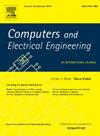Novel low-complexity transceiver design for UFMC system with two-stage filtering
IF 4
3区 计算机科学
Q1 COMPUTER SCIENCE, HARDWARE & ARCHITECTURE
引用次数: 0
Abstract
Waveform design plays a crucial role in ensuring the seamless operation of next generation wireless networks. Orthogonal frequency division multiplexing (OFDM)-based waveforms are still in the interest and remain a viable candidate for the physical layer of the sixth-generation (6G) networks. Universal filter multicarrier (UFMC) waveform, a variant of OFDM, exhibits several advantages over traditional OFDM, particularly in terms of reduced spectral leakage and increased spectral efficiency. However, it comes with a higher computational complexity compared to the OFDM system, particularly during the subband-wise convolution phase at the IFFT outputs. Therefore, to alleviate some of the complexity challenges in practical applications, it is essential to redesign the algorithms at both the transmitter and receiver sides. In this paper, we propose an architecture for the UFMC transmitter by incorporating a two-stage convolutional filtering approach at the transmitter side to reduce complexity. Through numerical analyses, we demonstrate a significant reduction in complexity-over 80% fewer multiplications — while also achieving a slight improvement in bit error rate (BER) performance compared to the conventional scheme. This proposed architecture presents a promising solution to tackle the complexity challenges encountered in UFMC systems, making them more viable for practical implementation in various communication environments.
采用两级滤波技术的新型低复杂度 UFMC 系统收发器设计
波形设计对确保下一代无线网络的无缝运行起着至关重要的作用。基于正交频分复用(OFDM)的波形仍然备受关注,并且仍然是第六代(6G)网络物理层的可行候选波形。通用滤波器多载波(UFMC)波形是 OFDM 的一种变体,与传统的 OFDM 相比具有多种优势,特别是在减少频谱泄漏和提高频谱效率方面。然而,与 OFDM 系统相比,UFMC 的计算复杂度较高,尤其是在 IFFT 输出端的子带卷积阶段。因此,为了减轻实际应用中的一些复杂性挑战,必须重新设计发射端和接收端的算法。在本文中,我们提出了一种 UFMC 发射器架构,在发射器端采用两级卷积滤波方法来降低复杂性。通过数值分析,我们证明了复杂性的显著降低--乘法次数减少了 80% 以上--同时,与传统方案相比,误码率 (BER) 性能也略有改善。这种拟议的架构为解决 UFMC 系统中遇到的复杂性难题提供了一种前景广阔的解决方案,使其在各种通信环境中的实际应用更加可行。
本文章由计算机程序翻译,如有差异,请以英文原文为准。
求助全文
约1分钟内获得全文
求助全文
来源期刊

Computers & Electrical Engineering
工程技术-工程:电子与电气
CiteScore
9.20
自引率
7.00%
发文量
661
审稿时长
47 days
期刊介绍:
The impact of computers has nowhere been more revolutionary than in electrical engineering. The design, analysis, and operation of electrical and electronic systems are now dominated by computers, a transformation that has been motivated by the natural ease of interface between computers and electrical systems, and the promise of spectacular improvements in speed and efficiency.
Published since 1973, Computers & Electrical Engineering provides rapid publication of topical research into the integration of computer technology and computational techniques with electrical and electronic systems. The journal publishes papers featuring novel implementations of computers and computational techniques in areas like signal and image processing, high-performance computing, parallel processing, and communications. Special attention will be paid to papers describing innovative architectures, algorithms, and software tools.
 求助内容:
求助内容: 应助结果提醒方式:
应助结果提醒方式:


